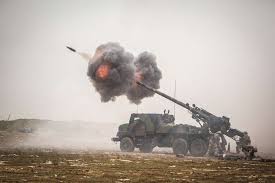
KNDS, the French-German defense group behind the Caesar truck-mounted 155 mm howitzer, says the system has strong prospects in the U.S. Army’s competition to replace the M777, according to the company’s marketing chief for the weapon.
Olivier Fort, a former French artillery colonel who now works for KNDS, told reporters after a live-fire exercise at the Canjuers range in southeastern France that American artillery crews already hold the Caesar in high regard, having observed it in action in Iraq and Afghanistan.
Earlier this month KNDS announced a teaming agreement with Leonardo DRS to offer the Caesar for the U.S. market. Industry watchers expect the Army could order roughly 400 self-propelled howitzers to succeed the towed M777, though Fort said he had not yet seen a formal request for proposals as of Monday.
Fort noted that French forces operated the Caesar alongside U.S. units in Iraq and Afghanistan, and that those deployments helped build the gun’s reputation among U.S. artillerymen. He added that Iraq was a particularly demanding environment because French crews fired a large share of rounds at very long ranges — a key performance test for the system.
According to figures KNDS supplied, French Caesar crews fired about 18,000 rounds in Iraq, and roughly 70% of those used five or six propellant charges. Six charges is the maximum for the 52-caliber variant and enables a firing range of about 40 kilometers.
To date KNDS says it has sold more than 720 Caesar howitzers to 14 countries, including roughly 120 truck-mounted units delivered to Ukraine. The platform is available on six- and eight-wheel truck chassis; the company is also developing a Mark II six-wheel variant with improved cabin armor and a stronger engine, which is due to enter French service beginning in 2027.
The Caesar took part in a U.S. Army artillery shoot-off in 2021 alongside other contenders such as Elbit’s Atmos and BAE Systems’ Archer. Fort argued KNDS now has an edge because, apart from Ukraine’s indigenous Bohdana, Caesar is the only truck-mounted cannon currently operating in Ukraine — a real-world testbed that has allowed continuous refinement driven by Ukrainian feedback.
Fort expects the upcoming U.S. competition to be narrower than the 2021 event and to involve only a small number of guns, although he cautioned the process is subject to change. He identified Elbit and BAE as competitors and said KNDS Germany will field the RCH 155; Rheinmetall is also likely to participate, possibly in partnership with Elbit.
Fort pointed out that the U.S. has a very large artillery force with multiple modernization needs — while current focus may be on replacing the M777, other platforms such as the M109 could come under consideration later.
Because the U.S. prefers domestically produced weapons, KNDS partnered with Leonardo DRS so the Caesar offer would meet that requirement. Fort emphasized that Leonardo DRS is a substantial American firm and that, under the partnership, the Caesar system including its barrel would be manufactured in the United States.
He contrasted French operations in Iraq — which often used maximum propellant charges for extreme range — with practices in Ukraine, where crews frequently use fewer charges to preserve barrels because replacement availability is not guaranteed. As a result, Ukrainian crews commonly fire with three or four charges rather than five or six.
Finally, Fort said the U.S. is studying technical lessons from Ukraine rather than tactical ones, since American doctrine for integrating air assets and air defenses differs from Ukraine’s. He added that, from a weapons-performance standpoint, Iraq presented tougher demands than Ukraine.




